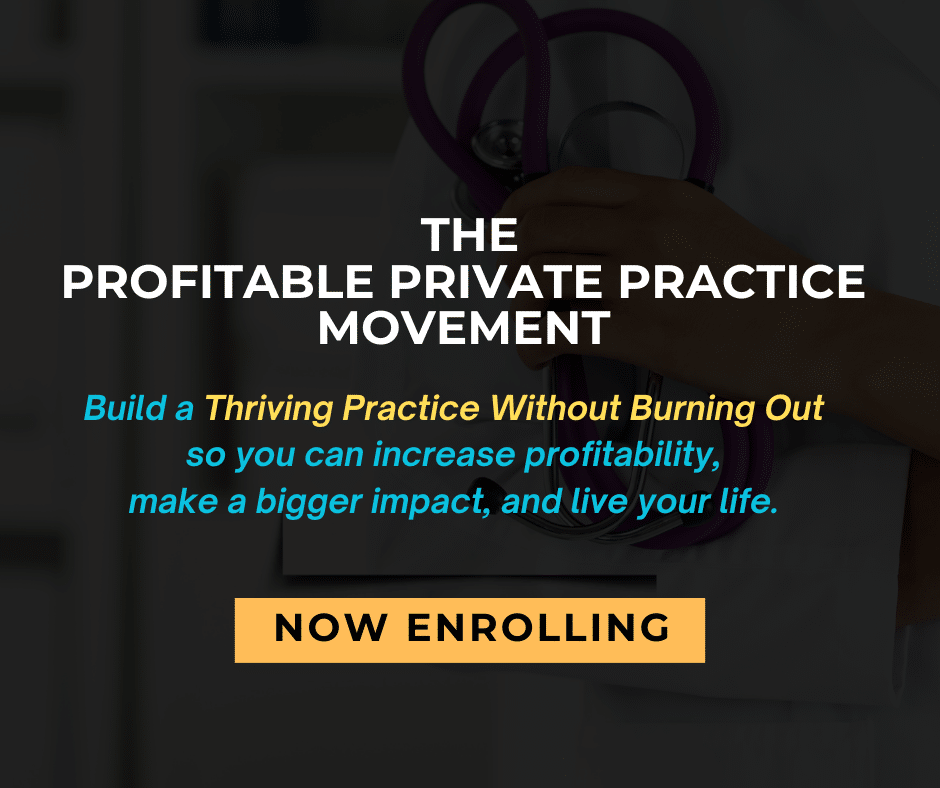
It’s hardly a secret that statistics show soaring rates of job dissatisfaction and burnout among physicians, doctors, and other healthcare professionals. Add a global pandemic to already high levels of this dissatisfaction and burnout, and no wonder many of us are struggling.
A recent sourced article said few doctors would currently recommend a career in medicine. Not only would they not recommend a medical profession, but they would also actively discourage it.
According to another source, only 1 in 10 doctors would recommend a career in medicine—what a depressing thought.
Why are so many doctors so unhappy with their jobs? What is so challenging about being a doctor when the general public admires us and assumes we must make more than enough money to be happy?
It didn’t take me long to find two significant reasons why many doctors are unhappy with their jobs:
- The corporatization of healthcare
- The price their patients pay
Everywhere I looked, and everyone I spoke to said the same thing, “Burnout.” This buzzword is the shorthand for everything from depression to exhaustion to an alarming increase in the suicide rates among doctors and physicians.
The Corporatization of Healthcare
Without a doubt, there are profound failures in our current healthcare system. These failures seem to fall into two categories: bureaucracy gone crazy and the frustration of overwhelming documentation requirements. Sound familiar?
The bureaucratic problem
According to MedPage Today,
“Medicine is no longer about independent practice doctors who have (a certain degree of) autonomy and control.”
The healthcare landscape drastically changed when doctors became the employees of large healthcare organizations and in service to someone other than the needs of their patients. The strict and excessive bureaucratic requirements we all face place far too many obstacles between us and delivering the patient care we became doctors to give.
A July 13, 2019 article on KevinMD.com is blistering in its criticism of healthcare organizations. In talking about the obstacles placed between the healthcare professional and patient care delivery, Dr. Suneel Dhand, MD, bluntly says that [healthcare] organizations dress up the negative aspects of the system, seduce potential doctor employees with a seemingly good package and benefits, impress with a shiny corporate logo and newly designed hospital. Still, it’s just lipstick on a pig.
Medscape’s 2019 report on physician burnout stated that 59 percent of physicians identified too many bureaucratic tasks as contributing most to their burnout.
Financial considerations between hospitals, health care systems, insurers, and patients lead to a conflict of interests for doctors. However, the well-being of their patients is far from the only consideration.
The introduction of the third-party payer system means that many doctors are now simply employees dealing with the “bosses” of insurance companies or the government. While our priority is on providing care, their priorities are focused on the financial bottom line.
Americans spend almost $3.5 trillion on healthcare. That is more than the total GDP of every country in the world except for China and Germany. And despite spending an almost unfathomable amount of money, the US came in last place worldwide for access, equity, and healthcare outcomes.
The “paperwork” problem
Currently, physicians spend almost 50% of their time documenting and only 27% with direct patient care. That translates to spending twice as long on record-keeping as we do with our patients.
Our patient care time is gobbled up by the never-ending need to satisfy nonclinical authorities, fill out countless forms, enter rivers of data into the EHR and spend hours arguing with insurance companies to get our patients the care they need and deserve. One source says that physicians spend more time caring for the computer than their patients.

These hours away from patient encounters are very good at tracking productivity and other business metrics but are even better at overwhelming doctors in their commitment to care.
The Massachusetts Health and Hospital Association and the Massachusetts Medical Society have put together a statewide Physician Burnout Taskforce that is made up of 15 MDs and one medical student. Dr. Steven Defossez, VP of Clinical Integration at the Massachusetts Health and Hospital Association and one of the Co-Chairs of the task force, says:
Doctors “forced to use still-primitive EHRs” have become “the most expensive data entry clerks on the planet.”
Dr. Suneel Dhand is calling a code blue technology on the “suboptimal, clunky and inefficient technology” problem still in daily use by doctors and nurses. He claims it is the number one driver of physician job dissatisfaction and “has caused…misery for physicians all over America.”
In no other profession would you spend five times the amount of time documenting what you just did, compared to the amount of time spent doing it!
Dr. Rosalind Kaplan, MD, agrees. While she says she is burnt out, “I’m fried, in fact.” But her burnout isn’t a result of taking care of her patients. Instead, it stems from taking care of the charts, using the EHR, and trying to document and bill correctly, along with all the other digital details that come with a medical practice.
The Price Their Patients Pay
Of course, the consequences of the maddening bureaucracy and disproportionate time spent at the computer mean that some medical care areas have to suffer, and far too often, the patients we see.
Growing patient panels
There is simply no way doctors can see the forty, fifty, or even sixty patients a day that health care policy and insurance reimbursement demands and still give good care in the five to seven minutes this allows.
But this caseload isn’t uncommon.

If every patient was young and healthy, needing a simple physical exam, or a stable patient needing a prescription refill, that might work. But any patient with a complex medical history, and let’s face it, that is becoming more common all the time, requires more than a quick in-and-out visit with their doctor.
The current healthcare system rewards speed of diagnosis and procedures more than patient interaction. As a result, the time it takes to listen, ask probing questions, give physical exams, look for all possible signs and symptoms of disease progression, counseling, and working to stay ahead of a disease actively isn’t given the priority most doctors know is critical to care.
Patient needs and expectations
A changing landscape in medicine has patients and their families demanding much more from their physicians than in the 1970s. Options in treatments have exploded, and patients expect their doctors to be on the cutting edge of medical breakthroughs.
Along with these expectations, our aging population requires more time as their health issues are more complicated. And if the elderly patient isn’t demanding more solutions to their health care concerns, their families certainly are.

Sandeep Jauhar’s memoir Doctored writes,
“Unhappy doctors make for unhappy patients.”
He tells how differently medicine was practiced when patients referred to their doctor as “my” doctor. Now, in any given year, it’s not uncommon for a patient to see two primary care physicians and five specialists working in different practices. A one-to-one relationship with a primary caregiver is becoming an increasingly rarer experience.
According to Jauhar’s research, only six percent of doctors are happy with their jobs. They commit suicide at twice the rate of the general population. Over half are unsure they would recommend the practice of medicine to young people.
He goes on to write,
“Patients today are increasingly disenchanted with a medical system that is often indifferent to their needs…Insensitivity in patient-doctor interactions [has] become almost normal.”
Reviewers sum up the thesis of his book by noting,
“Doctors have become like everyone else: insecure, discontent and scared about the future.”
How can we be happy when we know our patients feel unheard and unprioritized?
Welcome to the Burnout
The culture of American medicine rewards doctors and other healthcare professionals who work long hours, get most of their meals from a vending machine, and choose to care for patients’ physical and mental needs before their own.
In a 2022 report on physician burnout and depression, Medscape found that most physicians said that burnout permeates most aspects of their lives, with 54% indicating that the impact was strong to severe.

Burnout is described as:
“Long-term, unresolved, job-related stress leading to exhaustion, cynicism, detachment from job responsibilities, and lacking a sense of personal accomplishment.”
The Physician Burnout & Depression: Stress, Anxiety and Anger Report cited these survey results as to which physicians are most burned out:
- Emergency Medicine: 60%
- Critical Care: 56%
- Ob/Gyn: 53%
While burnout increased for both genders, in 2020, surveys indicated that while 41% of male doctors reported burnout, 15% more female doctors (56%) said they were experiencing burnout.
This same survey asked doctors what they felt contributed most to their burnout:
- Too many bureaucratic tasks (60%)
- Lack of respect from admin/employers/colleagues/staff (39%)
- Too many hours at work (34%)
Moral injury
Some research goes so far as to state that the unhappiness doctors experience in their jobs goes far beyond burnout. A Washington DC-based psychiatrist, Dr. Wendy Dean, says that “It’s much, much worse.” She calls it a moral injury.
Dr. Zubin Damania agrees with her findings. On a recent YouTube video, Nearly 600k viewers listened as Dr. Zubin candidly talked about the condition of moral injury and how being a physician can be like going into battle.
A compelling article at Stat makes a distinction between burnout and moral injury and how, unless we understand this distinction:
“Wounds will never heal, and physicians and patients alike will continue to suffer the consequences.”
The trouble with the term “burnout” is it suggests that failure lies within the doctors.
Most doctors feel their career is a calling rather than a job. As a result, they endure lost sleep, lost years of young adulthood, huge opportunity costs, family strain, financial instability, disregard for personal health, and many other challenges for the privilege of helping people.

Doctors are by nature deeply compassionate and committed to making sure their patients have the best possible care. And that’s where moral injury comes into play.
In 2019 Marcela G. del Carmen MD, MPH, stated in a recent Helio article that:
“Physical burnout is negatively associated with altruism, professionalism and quality and safety of care.”
How ironic that the very qualities patients look for in their doctors have negative implications for the doctor. The conflict between caring for patients and satisfying the demands of their healthcare employer means their job satisfaction and patient care will always be at odds with each other.
The term moral injury was first used to describe the responses soldiers had to their actions in war. In veterans, the diagnosis is post-traumatic stress; it’s called burnout for doctors.
Moral injury in soldiers has been described as:
“Perpetrating, failing to prevent, bearing witness to, or learning about acts that transgress deeply held moral beliefs and expectations.”
Simon Talbot and Wendy Dean talk about moral injury in healthcare as doctors being unable to provide high-quality care and healing in the context of healthcare. Failing to meet their patients’ needs has a profound impact on the health and well-being of doctors; this is their moral injury.
Every day, doctors find themselves torn between conflicted allegiances — to their patients, themselves, and their employers. As a result, they are experiencing moral injury and a collapse of resilience.
Navigating the conflict between the Hippocratic oath and the realities of making a profit from the sickest and most vulnerable leaves doctors emotionally and morally exhausted. The everyday suffering, anguish, and inability to deliver the care patients need is deeply painful.
The underside of medicine
A deeply compassionate Tedx Talk, “Doctors in Distress: Saving the Lives of Those Who Save Lives,” was given by Dr. Ed Ellison, board-certified in Family Medicine and a diplomat of the American Academy of Family Physicians. In this talk, he pulls back the curtain on one of medicine’s most critical issues: the suffering of doctors.
Dr. Ellison describes the average characteristics of devoted perfectionistic doctors who are conditioned to “suck it” up and do whatever it takes to get the job done. Whether it requires all-night shifts, no sleep, junk food for dinner, no exercise, little to no self-care, doctors do it in the name of care.

He points out that what they learn to do is swallow their pain and fear of failing or letting someone down, or dying.
“Doctors are people who never give up. Until they do.”
Giving up can look like this:
- Losing energy and engagement in the things that matter to them
- Becoming disengaged and detached from the people who matter — patients, friends, and family
- Feeling ineffective and unable to accomplish anything
- Feeling like quitting
A state of chronic stress (burnout) can look like this:
- Emotional exhaustion
- Physical exhaustion
- Insomnia
- Loss of appetite
- Loss of focus
- Anxiety
- Depression
- Detachment
Many previously well-adjusted and engaged doctors are currently being stressed to the breaking point. They are dealing with this in several ways:
- Retiring early
- Reducing their practice
- Leaving medicine
“But it gets darker.”
One doctor in the US commits suicide each day. The highest suicide rate in any profession. Doctor suicides — 28 to 40 per 100,000 — are more than twice that of the general population.
In the last two years, the rate of suicide among male physicians has been 40% higher than the general public. Men tend to experience burnout as detachment and disengagement.

For female physicians, the rate of suicide is even bleaker. Female physicians’ rate of suicide is 130% higher than the general public. However, because of their gender and the greater expectation for empathy, these women doctors tend to give until they have nothing left to give.
This translates to 300-400 doctor suicides each year.
Conclusion
Doctors aren’t simply “unhappy” with their jobs. Their unhappiness doesn’t stem from “frivolous” concerns.

Fixing the healthcare system will take the wisdom of Solomon, but without a dedicated effort from everyone involved, we will continue to be unhappy as healthcare workers.
In the meantime, if you’re a doctor and you’ve had enough of the corporate-formed, paperwork-riddled healthcare landscape, you can join thousands of others in forming a private practice of another business. Live life on your terms, practice medicine in a way that helps people and not administrators, and be successful in the way you want to be. I’m here to help you do just that, so contact me today to find out how.



